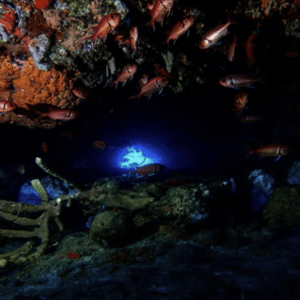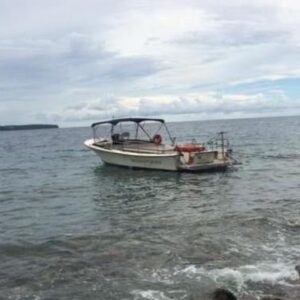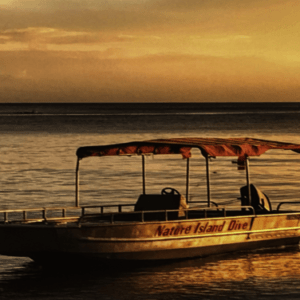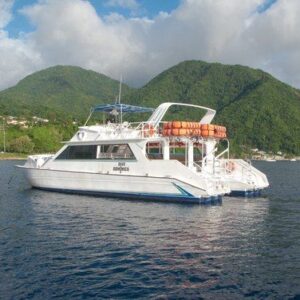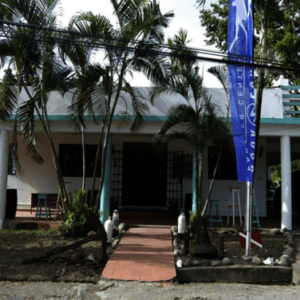Not yet overtaken by tourism, Dominica is a small island in the Caribbean. Voted in 2017 by Lonely Planet as one of the top countries to visit in the world, it is surprising that not more people visit Dominica. This mountainous island is an unknown diving destination and is a wonderful place to avoid crowds both above and under the water. Dominica is rich with natural hot springs and tropical rain forests as well as fantastic dive sites for all levels of scuba divers. There are calm shallows to explore and deeper waters containing over 20 species of whale. The diverse underwater landscape features volcanic vents, dramatic walls, and colorful marine life. The biggest attraction in Dominica is the seeing and swimming with Sperm Sharks.
Known in the Caribbean as the Nature Isle, this island is as pristine today as it was hundreds of years ago.
GETTING THERE
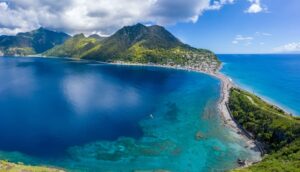
Air: Melville Hall Airport and Canefield Airport welcomes guests from one of the other Caribbean hubs.
GETTING AROUND
Rental Car: With the island’s points of interest and diving sites scattered over the island, renting a car is the best way to move around the island.
GOOD TO KNOW
Country: Dominica is an island country of the Lesser Antilles in the eastern Caribbean Sea
Time Zone: UTC-4
Primary Language: English
Currency: XCD East Caribbean Dollar
Cell Phone Service: There are 3 mobile service providers on the island or roaming charges apply.
Voltage: 230V with Type D and G Plugs
Passport and Visa: A valid passport is required with at least 1 blank page for entry stamp. No visa is required for stays less than 6 months with proof of return ticket.
Hurricane Details: Hurricane season is from early June to late November.
DIVE CONDITIONS
Water Temperature: mid 80s in the summer and 70s in the winter
Water Visibility: 60-100 feet
When to Go: November through March is the most popular time to visit the island. This time is when pods of sperm whales stay close to the island.
Diving Difficulty: Beginner-Advanced
TOP DIVE SITES IN DOMINICA
Dominica caters to the diving enthusiast! Listed are some of the very best that this island can offer divers:
Dangleben’s Pinnacle is a series of five pinnacles named for the Dangleben family who owned the land at the edge of this dive site. Located on the northern edge of the Soufriere crater, this dive is one of the deeper dives in Dominica. Here, divers will see a variety of Caribbean creatures, and gargantuan barrel sponges.
Scotts Head Pinnacle: This dive is known as the most spectacular swim-through dive on the island. Beginning at a large rock formation called Swiss Cheese, divers see schools of soldier fish, and grunts as they pass through the rock formation. At a depth of 53 feet, a labyrinth of hills, valleys, a wall, and a flat shelf create an underwater obstacle course for divers. Crossing the garden of lace coral, sea rods and sea fans finds a volcanic crater that offers dramatic underwater topography.
Point Break offers divers the opportunity to observe an abundance of fish. The current here is strong but the wall, underwater landscapes, and marine life make this site worth seeing.
Champagne Reef is named for the water bubbles that rise from the water and surround divers giving the feeling of being in a champagne glass. These bubbles are made from the volcanic thermal springs on the ocean floor that vent through small fissures in the hard coral. This site is well known and perfect for both snorkeling and scuba diving and is one of the few shore dives on the island. A large variety of marine life inhabits this area even with the elevated water temperature in the shallows. The mild currents give divers the opportunity to spot seahorses, frogfish, and squid.
Shark’s Mouth is a wall located around Cabrits National Park in Prince Rupert Bay and named after the huge basket sponges with jagged tops that resemble a shark’s mouth. The dive site is buoyed and has a rocky bottom. The dive follows a steep, rocky slope that is covered in barrel sponges and hard corals. Due to its sheltered location, visibility is exceptionally good, and divers can expect to see enormous feather stars, hard corals, sponges, and small fish including spotted morays and spotted drums. The dive also features a gigantic boulder that was dropped here from a landslide.
Five Fingers has a similar underwater geography to Shark’s Mouth. Located at the northwest tip of Cabrits Head, the site has mild currents with an abundance of squirrelfish, flounders, tabaco fish, angel fish, copper sweepers, rock beauties, butterfly fish, trunk fish and spotted eagle rays. Divers might be lucky and spot turtles and stingrays.
Hot Sophia is a gentle depression at 80 feet where sulfur bubbles, hot water, and deep reef with volcanic activity can be found. There are several square miles that are extremely hot to the touch. Around the reef, divers can expect to see a seabed with many basket sponges, moray eels and soft and hard corals.
Maggie’s Point is one of the few isolated sites in Dominica and located off Mero Bay. Extending offshore to the west and separated by sand valleys, Maggie’s Point is made up of several lava flows. These lava flows are covered with sponges and crinoids. Divers can expect to see copious quantities of tropical fish and well-camouflaged scorpions and stingrays.
Batalie Reef is a magnificent day and night dive. Starting at the beach the gradual descent makes this site ideal for beginners. Divers will enjoy a variety of fish such as morays, octopus, basket stars and barracuda.
Cannon Site is home to the purposely sunk wreck called The Nadine L. This 55-foot wreck is perfect as an introduction to wreck exploring. This wreck dive is home to stingrays, electric rays, angelfish, and decorator crabs.
Rodney’s Rock is ideal for scuba diving and for a discovery in PMT. This rocky advance is home to tropical reef fish and enormous quantities of seahorses. Close to the rock, divers can swim through a high slit where lobsters hide.
Whale Shark Reef is decorated with corals and giant sponges which is home to tuna, barracuda, Spanish mackerel, and jacks. This impressive drop hides turtles within the cavities of the cliff.
L’abym (la sourcieer) means “the abyss.” This site has the most vertical walls of the island. It is covered with healthy barrels, anemones, tubes and home to stingrays, scorpion fish, lizards, trumpets and renowned macrofauna. This is a perfect spot for photographers. L’abym is a steep underwater cliff.
Toucari Caves and Reef is an incredible landscape with canyons, caves, and healthy reefs brimming with marine life including frog fish, angels, butterflies, wrasses, and barracuda. Tube reef is found along the reef of Toucari along the 92-foot-deep cliff wall where divers will spot garden eels, sea turtles, eagle rays and stingrays.
The Witch is a 16-foot anchorage that drops immediately to an abyss. The Witch is located under a cliff known as The Witch. Legend tells a story of the island’s inhabitants pushing their unfaithful bride from the top of it. Divers can spot scorpion fish and large rays.
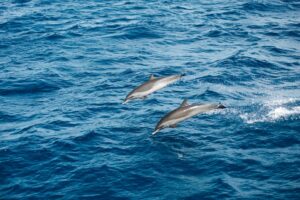
TOP ATTRACTIONS IN DOMINICA
With volcanic peaks, lush rainforests, sparkling waterfalls and rugged coastlines, Dominica is a wonderful place for topside adventures.
Historic Roseau is located in the capital city and surrounded by the Caribbean Sea, the Roseau River and the Morne Bruce. This quaint town is full of 18th century French architecture. The Old Market Square, formerly the original slave market, is home to craft vendors that cater to cruise ships. The Visitors Information Center is in the Old Post Office building. Visitors can visit the Dominica museum which is home to a small collection of artifacts tracking the islands history. Other sites in this area include The New Market on the Riverbank which hosts fresh tropical fruit, vegetables, and herbs. Located just above the Botanical Gardens, Morne Bruce provides visitors with panoramic views of the city. Other places to visit, all located on Victoria Street, include the Cenotaph, Slave monument, Fort Young Hotel, President’s Office, and the Carnegie Library.
Boiling Lake is a 200-foot-wide flooded fumarole from a volcano known as the Valley of Desolation. The lake is encircled by spinning clouds of vapor which resembles a cauldron of bubbling blue-grey water. Heated from the molten magma below the surface of the surrounding rock is only outdone with the breathtaking vistas that surround it with clear views of the ocean, and the neighboring island Martinique. The terrain around the lake has been shaped by erosive and volcanic forces of nature for over 200 million years. Visitors can hike this area but is considered one of the most demanding hikes on the island. Those wanting to experience this adventure are encouraged to hire a guide to help navigate the terrain.
Cabrits National Park is a 1,313-acre park established in 1986 and located on the north end of the island just beyond the town of Portsmouth. The park is nestled between two low-rising extinct volcanoes which have spectacular views of the beaches below.
Calibishie is an ancient fishing village on the north coast of Dominica. Calibishie is home to a mosaic of steep cliffs, red rocks, and rivers flowing down from the mountains. This village offers visitors a slow-paced place to relax and unwind with beautiful freshwater bathing pools, waterfalls, and tropical rainforests. The reefs and surrounding land provide Kalinago-Dominicans Indigenous people a perfect place for fishing.
Emerald Pool is a beautiful pool of water that appears emerald green due to the water feeding it from a 40-foot waterfall. The dramatic colors from the pool have served as the backdrop of several movies.
Kalinago Territory is home to the Kalinago, originally known as the Caribs. The Kalinago are the descendants of the island’s original people from South America. The Kalinago people are the last remaining tribe of Carib Indians. They are always eager to treat guests to the happiness of living with nothing more than what the land, sea and sky provide.
Dominica is an unspoiled and unforgettable island paradise. Scuba diving in Dominica submerses divers in an underwater world of volcanic vents, plunging sea walls, reefs with vibrant sponges, towering pinnacles, and caves. These tranquil Dominica waters host everything from hawk beak turtles to sperm whales, and barracuda to blue chromis. Dominica is sure to impress any diver.

